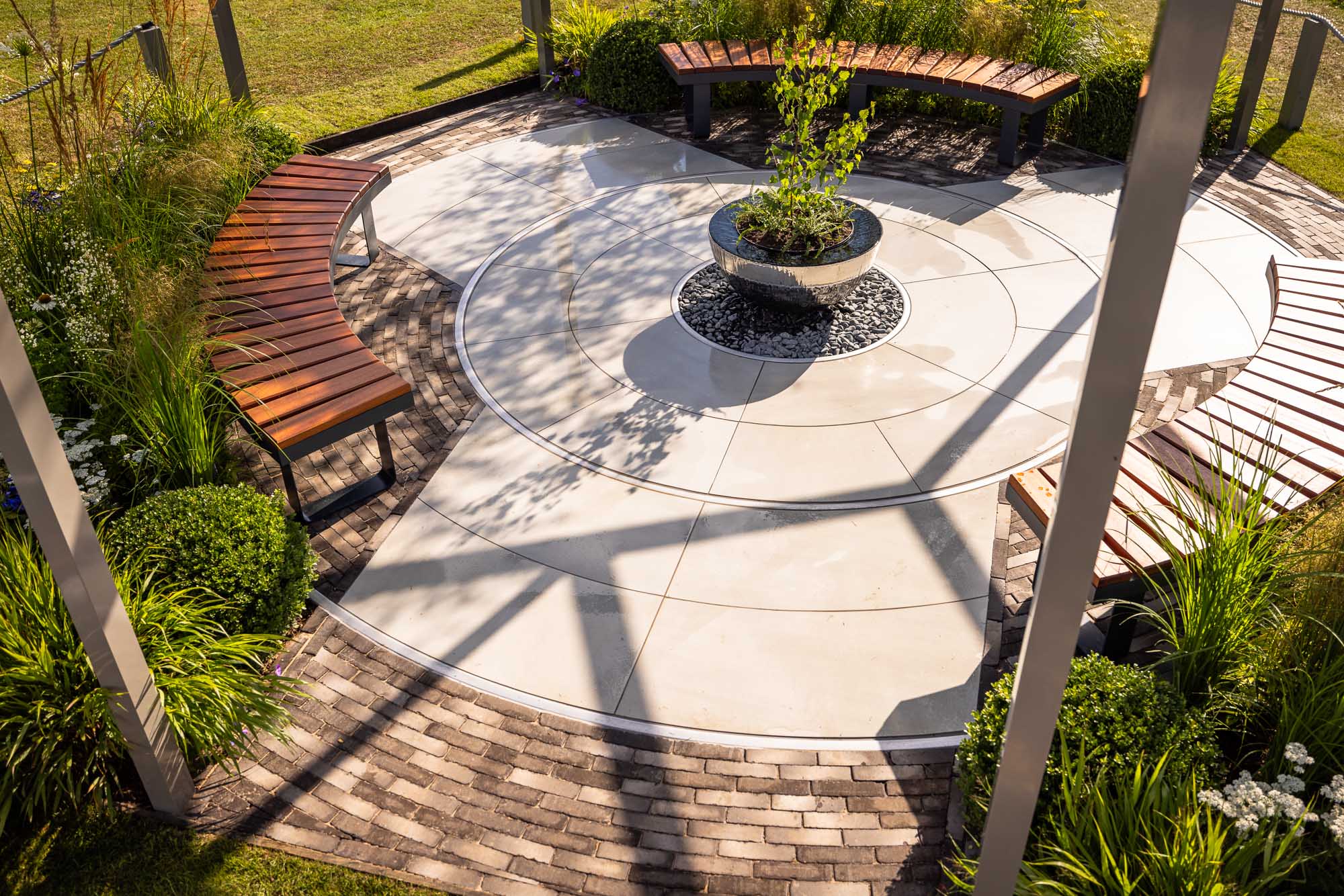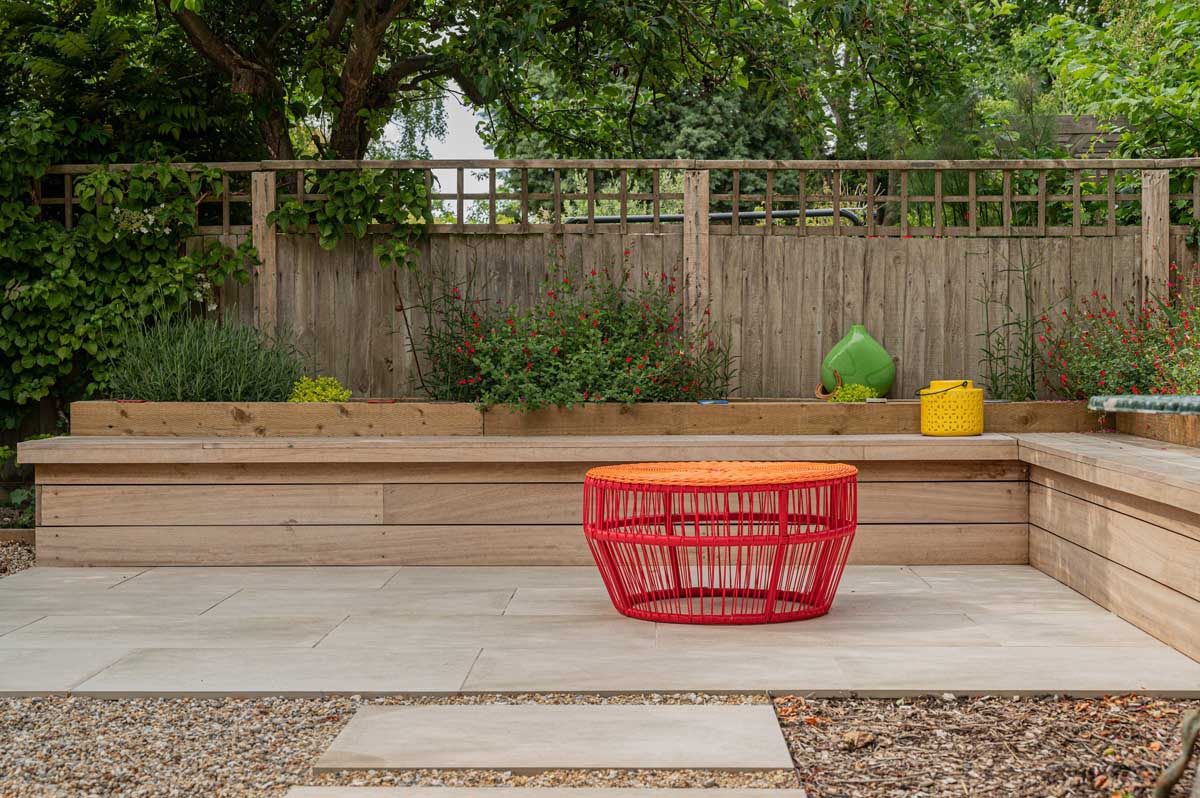Garden paths should do much more than just lead you to the shed. They’re integral to a garden's feel and appearance. We look at what to consider when designing a garden path.
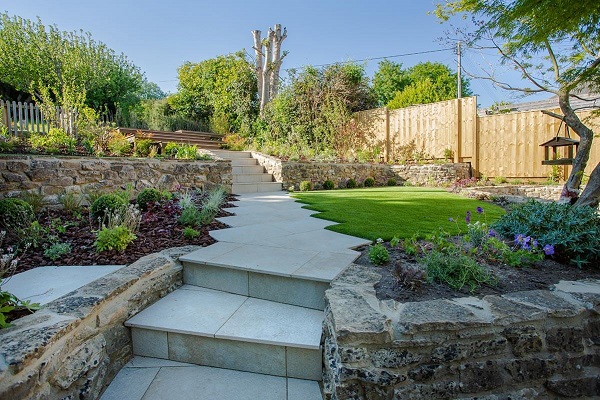
Placing a path
Obviously, a path is there to get you from A to B, whether you’re fetching the lawnmower or going to sit in the arbour. How it does it, though, is what separates good design from bad.
The most successful garden paths feel unforced. A garden path should feel like a natural addition, taking you from where you want to start to where you need to go, enhancing the journey. It should only encourage exploration where appropriate.
Tip: Think carefully about how you use the garden, your starting points and where you want to go.
Curves vs straight edges
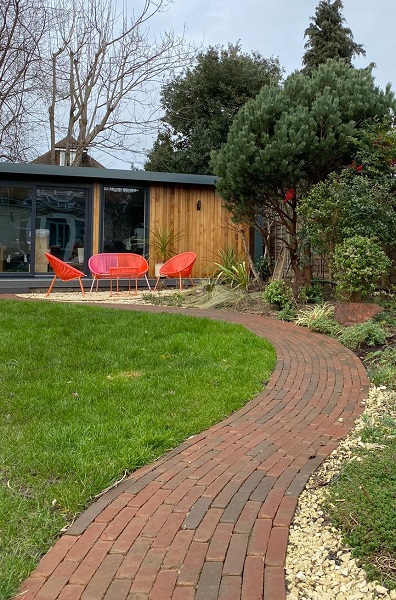
This is one of the most important decisions, very much related to where you’re going and what you’re doing. Meandering garden paths encourage you to linger and look. They entice you to explore.
However, no one wants to be taken out of their way when they have a goal, so a wide-curved path to the outdoor sofa will almost certainly make you abandon it for a a walk across the lawn. This “line of desire”, as it’s called, will eventually result in an obvious line in the grass, giving a constant reminder of poor design.
Straight paths can be every bit as enticing as one that curves mysteriously between trees, especially if they end in a focal point that draws you to it. If straight lines seem too formal, though, a slight wiggle relaxes the look while not taking you irritatingly out of your way.
Tip: fit the path to your needs in the garden, not the other way round. And don’t overdo curves when you have a destination to head for.
Choice of paving
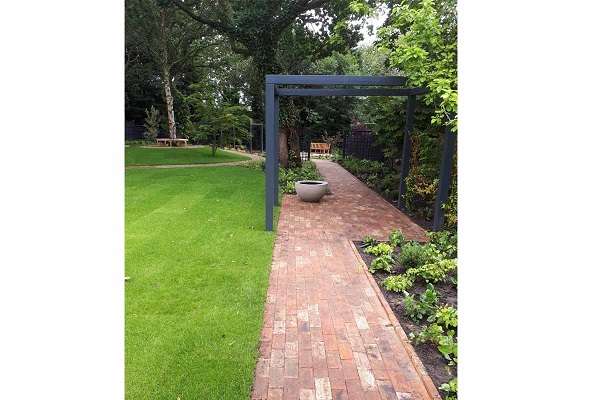
Porcelain and natural stone
As the writer of The Middle Sized Garden discovered, paving should suit the landscape.
A modern garden design with minimalist lines will most likely marry well with pathways in porcelain—perhaps large format slabs with few joint lines, or porcelain setts for a tile-like uniformity. If you prefer natural stone, then sawn paving will also create crisp lines.
A more relaxed design will enjoy natural riven stone, such as Indian sandstone or limestone, which may blend better with the architecture of the house.
Clay pavers
Clay pavers are well worth considering, as their small size allows curves to be created more easily than large paving slabs, which will need cutting. (For this reason, setts are also useful for curves). The huge range of earthy colours available in clay paving, as well as the different brick shapes and textures, make it easy to match them to surrounding brickwork and materials. Find out more about the advantages of clay paving.
You may decide that different parts of the garden require a different ambiance, and a different path material because of it. However, using the same material throughout, matching it to patio paving too, is the key to using paths to help unify your space.
Tip: Take time to consider how different materials will impact the appearance of both path and garden. On our paving product pages you’ll find colour swatches and, where applicable, a gallery of possible colour and pattern variations.
Proportions
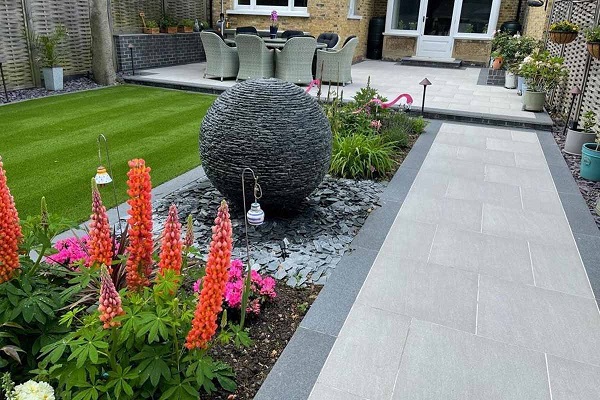
The width of a garden path can make or break your enjoyment of it. Ideally, it should be wide enough for two people to walk side by side. In a large garden, where this is possible, a narrower path would look miserly and out of proportion.
The ideal width is not always possible. A wide path in a small garden is also likely to be out of proportion and too dominant. In this case, though, if a certain width is required, perhaps for a wheelchair, the lack of proportionality can be disguised with planting and layout.
Tip: Think about width of your path as a proportion of the size of your garden.
Direction of paving
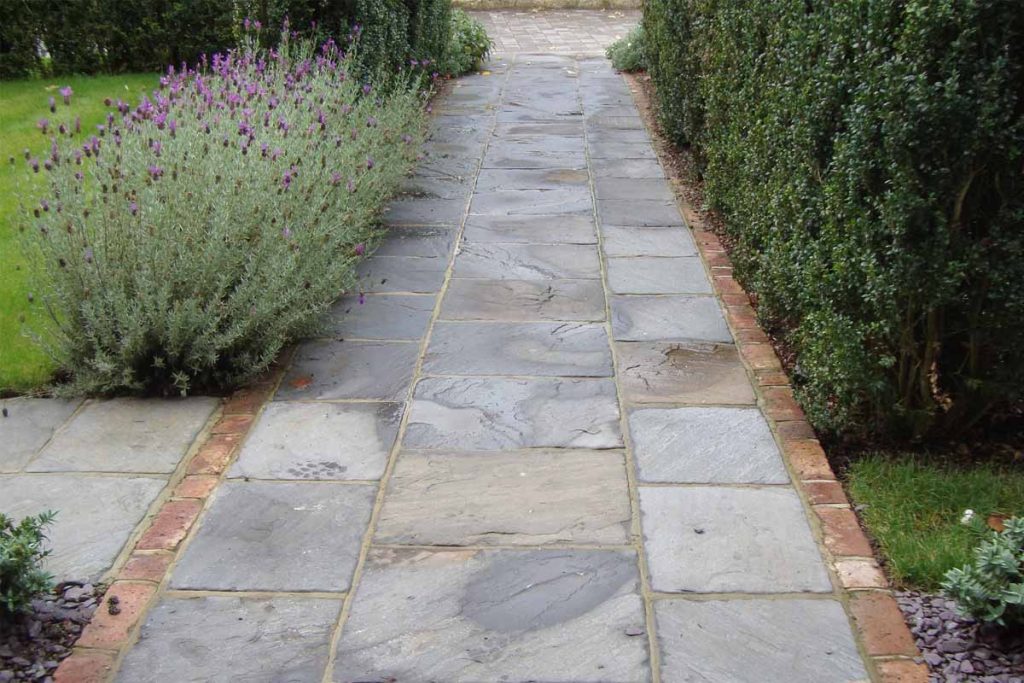
The direction in which you choose to lay your paving can have quite an impact on the feel of your garden path. In the front garden pictured above the Tumbled Black sandstone has been laid so that the jointing between the slabs creates lines that lead the eye straight along the path. This adds flow to the design and is a nice touch in a front garden which welcomes visitors to the front door.
Compare this with the path in Urban Grey porcelain above it. Even with the border edging tiles, progress along the path feels slower because the jointing lines run across the path, so the flow of the path doesn't rush past the planting.
The borders
Low-growing plants that tiptoe over the edge of the path soften the outline. This is an easy way to make the path feel long-established as well as disguising the linearity of the edges.
However, this linearity may be exactly what you want, especially for a modern design, which often displays block shapes and colour. Or this may be the opportunity to create some contrast with strong lines elsewhere by softening path edges with creeping plants or even allowing them to encroach between slabs, something you often see with narrow paving formats. Find out more about designing paths with plank paving.
Tip: Think about the planting at the same time as deciding on your path.
Steps
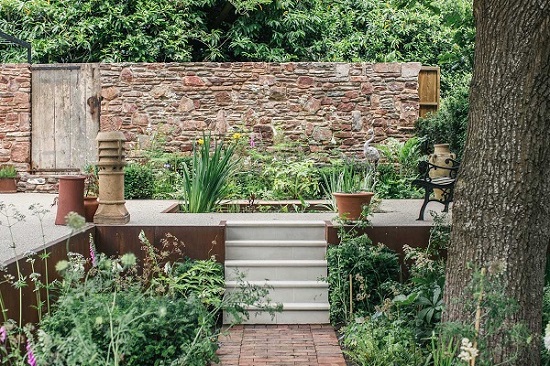
And don’t forget the role of steps in garden design. A wide, straight flight will fit easily into a more formal garden, but elsewhere a curve can, not only allow for shallower steps, but make it a more interesting descent as your view alters with the change in direction. Matching steps to pathways is another element in uniting a garden layout.
Tip: Treat level changes as an opportunity to create interest and give a path character, rather than as a nuisance to overcome.
With so many options for designing a garden path, our sales team are always on hand to talk through any questions you may have, and provide ideas and alternative solutions. Or why not visit one of our showrooms to see the materials on offer?
Updated: March 2024


/filters:quality(60)/mediadev/media/menu-pics/all-porcelain.jpg )
/filters:quality(60)/mediadev/media/menu-pics/luxury-italian.jpg )
/filters:quality(60)/mediadev/media/menu-pics/premium-italian.jpg )
/filters:quality(60)/mediadev/media/menu-pics/budget-porcelain.jpg )
/filters:quality(60)/mediadev/media/menu-pics/large-format-porcelain.jpg )
/filters:quality(60)/mediadev/media/menu-pics/wood-effect-porcelain.jpg )
/filters:quality(60)/mediadev/media/menu-pics/porcelain-planks.jpg )
/filters:quality(60)/mediadev/media/menu-pics/porcelain-setts.jpg )
/filters:quality(60)/mediadev/media/menu-pics/browse-all-paving.jpg )
/filters:quality(60)/mediadev/media/menu-pics/stone-paving.jpg )
/filters:quality(60)/mediadev/media/menu-pics/interior-tiles.jpg )
/filters:quality(60)/mediadev/media/menu-pics/stone-effect-porcelain.png )
/filters:quality(60)/mediadev/media/menu-pics/wood-effect-porcelain.png )
/filters:quality(60)/mediadev/media/menu-pics/grey-porcelain.png )
/filters:quality(60)/mediadev/media/menu-pics/beige-porcelain.png )
/filters:quality(60)/mediadev/media/menu-pics/dark-porcelain.png )
/filters:quality(60)/mediadev/media/menu-pics/light-porcelain.png )
/filters:quality(60)/mediadev/media/menu-pics/patio-grout.jpg)
/filters:quality(60)/mediadev/media/menu-pics/primers.jpg)
/filters:quality(60)/mediadev/media/menu-pics/porcelain-blades.jpg)
/filters:quality(90)/mediadev/media/menu-pics/drainage.jpg)
/filters:quality(60)/mediadev/media/menu-pics/cleaners.jpg)
/filters:quality(60)/mediadev/media/menu-pics/all-stone-paving.jpg )
/filters:quality(60)/mediadev/media/menu-pics/all-sawn-paving.jpg )
/filters:quality(60)/mediadev/media/menu-pics/all-riven-paving.jpg )
/filters:quality(60)/mediadev/media/menu-pics/indian-sandstone.jpg )
/filters:quality(60)/mediadev/media/menu-pics/limestone-paving.jpg )
/filters:quality(60)/mediadev/media/menu-pics/granite-paving.jpg )
/filters:quality(60)/mediadev/media/menu-pics/slate-paving.jpg )
/filters:quality(60)/mediadev/media/menu-pics/yorkstone-paving.jpg )
/filters:quality(60)/mediadev/media/menu-pics/stone-pavers.jpg )
/filters:quality(60)/mediadev/media/menu-pics/cobbles-setts.jpg )
/filters:quality(60)/mediadev/media/menu-pics/plank-paving.jpg )
/filters:quality(60)/mediadev/media/menu-pics/paving-circles.jpg )
/filters:quality(60)/mediadev/media/menu-pics/bespoke-paving-1.jpg )
/filters:quality(60)/mediadev/media/menu-pics/edging-stones-1.jpg )
/filters:quality(60)/mediadev/media/menu-pics/prestige-stone.jpg )
/filters:quality(60)/mediadev/media/menu-pics/grey-blue-stone.png)
/filters:quality(60)/mediadev/media/menu-pics/swatch-black-dark.jpg )
/filters:quality(60)/mediadev/media/menu-pics/swatch-buff-beige-white.jpg )
/filters:quality(60)/mediadev/media/menu-pics/sealants.jpg)
/filters:quality(60)/mediadev/media/menu-pics/all-clay-paving.jpg )
/filters:quality(60)/mediadev/media/menu-pics/alpha-clay-pavers.jpg )
/filters:quality(60)/mediadev/media/menu-pics/cottage-garden-clay-pavers.jpg )
/filters:quality(60)/mediadev/media/menu-pics/kessel-garden-clay-pavers.jpg )
/filters:quality(60)/mediadev/media/menu-pics/artisan-clay-pavers.jpg )
/filters:quality(60)/mediadev/media/menu-pics/grey-blue-clay-paver.png )
/filters:quality(60)/mediadev/media/menu-pics/red-brown-clay-pavers.png )
/filters:quality(60)/mediadev/media/menu-pics/beige-buff-clay-pavers.png )
/filters:quality(60)/mediadev/media/menu-pics/composite-decking.jpg )
/filters:quality(60)/mediadev/media/menu-pics/designboard-decking.jpg )
/filters:quality(60)/mediadev/media/menu-pics/classic-designboard.jpg )
/filters:quality(60)/mediadev/media/menu-pics/brushed-designboard.jpg )
/filters:quality(60)/mediadev/media/menu-pics/grooved-designboard.jpg )
/filters:quality(60)/mediadev/media/menu-pics/millboard-decking.jpg )
/filters:quality(60)/mediadev/media/menu-pics/grey-decking.jpg )
/filters:quality(60)/mediadev/media/menu-pics/black-charcoal-decking.jpg)
/filters:quality(60)/mediadev/media/menu-pics/brown-decking.jpg)
/filters:quality(60)/mediadev/media/menu-pics/all-build-deck.png )
/filters:quality(60)/mediadev/media/menu-pics/stone-cladding.jpg )
/filters:quality(60)/mediadev/media/menu-pics/all-garden-walling-1.jpg )
/filters:quality(60)/mediadev/media/menu-pics/facing-bricks.jpg )
/filters:quality(60)/mediadev/media/menu-pics/garden-screening.jpg )
/filters:quality(60)/mediadev/media/menu-pics/all-steps-coping.jpg )
/filters:quality(60)/mediadev/media/menu-pics/stone-garden-steps.jpg )
/filters:quality(60)/mediadev/media/menu-pics/sawn-steps.jpg )
/filters:quality(60)/mediadev/media/menu-pics/riven-steps.jpg )
/filters:quality(60)/mediadev/media/menu-pics/yorkstone-steps.jpg )
/filters:quality(60)/mediadev/media/menu-pics/bespoke-steps.jpg )
/filters:quality(60)/mediadev/media/menu-pics/porcelain-steps.jpg )
/filters:quality(60)/mediadev/media/menu-pics/off-the-shelf.jpg )
/filters:quality(60)/mediadev/media/menu-pics/stone-coping.jpg )
/filters:quality(60)/mediadev/media/menu-pics/sawn-coping.jpg )
/filters:quality(60)/mediadev/media/menu-pics/riven-coping.jpg )
/filters:quality(60)/mediadev/media/menu-pics/yorkstone-coping.jpg )
/filters:quality(60)/mediadev/media/menu-pics/bespoke-coping.jpg )
/filters:quality(60)/mediadev/media/menu-pics/stone-pier-caps.jpg )
/filters:quality(60)/mediadev/media/menu-pics/porcelain-coping.jpg )
/filters:quality(60)/mediadev/media/menu-pics/all-bespoke-services.jpg )
/filters:quality(60)/mediadev/media/menu-pics/bespoke-paving-2.jpg )
/filters:quality(60)/mediadev/media/menu-pics/bespoke-steps-1.jpg )
/filters:quality(60)/mediadev/media/menu-pics/bespoke-coping-1.jpg )
/filters:quality(60)/mediadev/media/menu-pics/edge-profiles.jpg )
/filters:quality(60)/mediadev/media/menu-pics/masonry-services.jpg )
/filters:quality(60)/mediadev/media/menu-pics/deluxe-pergolas.jpg )
/filters:quality(60)/mediadev/media/menu-pics/proteus-pergolas.jpg )


